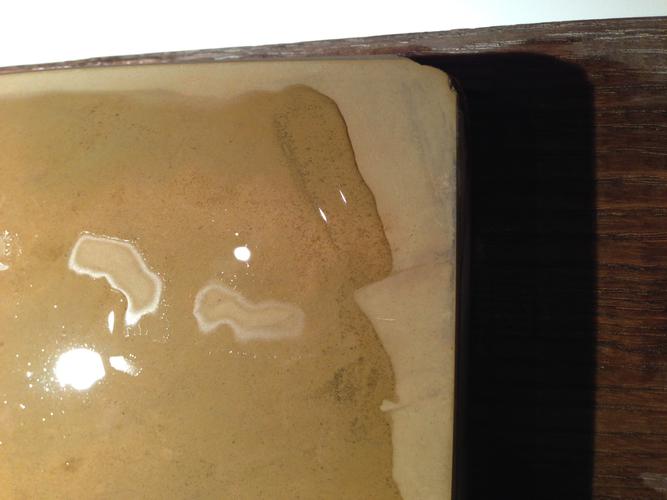Results 1 to 10 of 14
Thread: JNAT help
-
03-25-2015, 09:25 PM #1Junior Member

- Join Date
- Apr 2013
- Posts
- 8
Thanked: 0 JNAT help
JNAT help
I need some help with this JNAT. Got it from Japan about a year ago, and did not really have any info on hardness etc when I decided to buy it. I thought that it looked very nice and that (due to the size) it might very well be a razor stone.
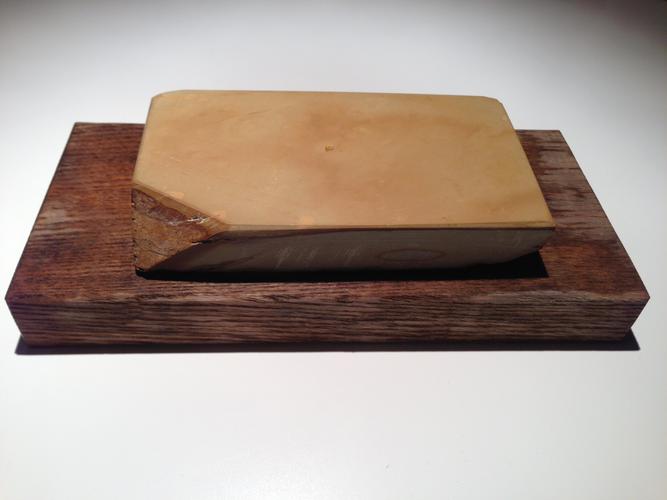
The stone is very fine and seems to be fast cutting (black swarf forms quite fast). It does not self slurry to any great extent.
When I raised slurry with my asano naguras on it I noticed that the slurry turned yellow/orange. The conclusion I came to was that the stone is quite soft, and therefore not that suited for razors.
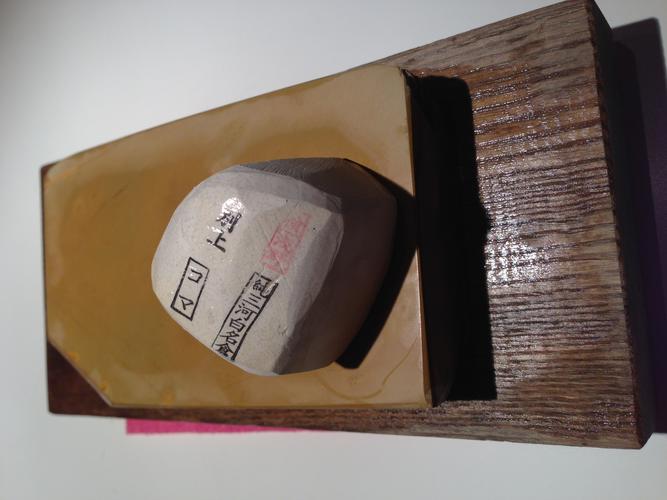
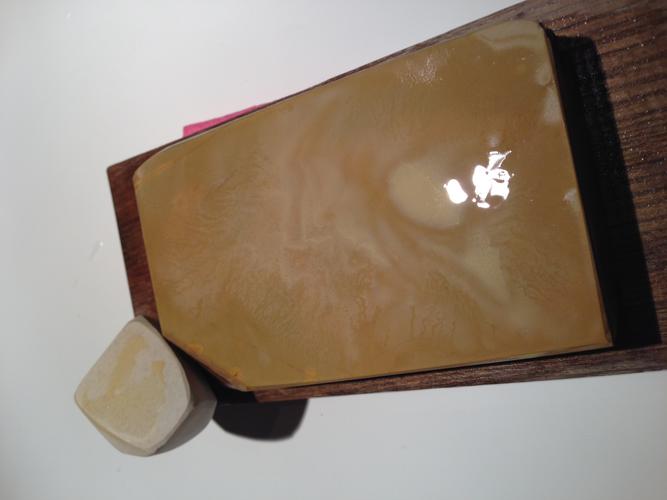
Since that the stone has not seen that much action, but maybe that is a mistake. Perhaps the "dis-coloration" of the slurry has no connection to the hardness of the stone, but rather that the iron oxide is released from rubbing the nagura on the hone.
Is yellow slurry to be expected from a stone of this colour, even if it is a hard stone?
Slurry after doing five strokes with a Tosuke kamisori, looks grey in picture but is more like black in reality.
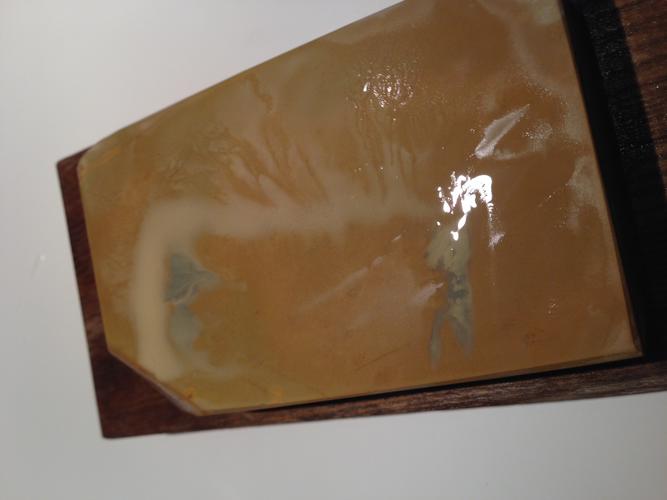
-
03-25-2015, 09:40 PM #2< Banned User >

- Join Date
- Dec 2012
- Location
- Long Island NY
- Posts
- 1,378
Thanked: 177
Ive had a few stones like that, I returned them as i was looking for a finisher. The nagura is harder than the base stone it seems. It may be a great pre finisher, but sometimes soft stones like that can release bevel killing particles. Cant say for sure though. You say the stone doesnt self slurry much? I use a blade on a clean stone then use a paper towel after to see how much slurry is released water only. I typically do on any new stone 100 half strokes to see how chippy it is or isnt. Look at the scratch pattern with the loupe water only, then with slurry only to see whats what. Anything too scratchy I have sent back though.
-
03-25-2015, 09:56 PM #3Junior Member

- Join Date
- Apr 2013
- Posts
- 8
Thanked: 0
-
03-26-2015, 12:13 AM #4Senior Member


- Join Date
- Jul 2011
- Posts
- 2,110
Thanked: 459
If the stone is relatively fine and hard enough to not slurry at all when you put clear water on it (and isn't scratchy), you'll be able to finish a razor on it.
There are a lot of stones on ebay that have nobody commenting on their hardness, though, nor fineness and they are being sold at what I'd consider to be dealer prices for a known stone.
I'm a big advocate of jnats, but they have to be awfully cheap to buy one that doesn't specify what it is. I know it's getting harder to find decent ones, but aframestokyo is a dealer I'd go to if I was looking to save money. Any of the razor sized and small bench stones that are $150-$300 with no information on ebay are to be avoided.
Anyway, use your stone, if it autoslurries it will leave a very hazy finish on the razor and an unsatisfactory edge.
-
03-26-2015, 09:58 AM #5Junior Member

- Join Date
- Apr 2013
- Posts
- 8
Thanked: 0
Got if from a japanese auction site, and it was not alot of money, so i dont really feel that was a bad deal. In comparision to other stones it does not seem that soft, I have a simple test to compare stones where i test which scracthes which.
What im wondering is if anyone else has experienced that nagura slurry turns yellow when produced on a stone that contains iron oxide (I assume the the orange in stone is iron), maybe it is to be expected?
-
03-26-2015, 11:29 AM #6Senior Member


- Join Date
- Jul 2011
- Posts
- 2,110
Thanked: 459
I don't think that it's oxidized nagura slurry, there is at least some base stone slurry in there.
I guess the only suggestion I'd have is that if you want to figure out if the nagura is shedding particles, you'll have to use diamond hone or something to raise a slurry with the base stone only, then look at the scratches under a loupe (or better yet under a microscope if you have it).
Then rinse the stone and raise slurry with the nagura and see if you see any difference - it should have some harsher scratches or be more cloudy if nagura particles are mixed in.
It's good you found somewhere to get one inexpensively when it's not a known quantity. I haven't seen any such thing on our ebay, but I have seen $800 500 gram stones where the seller doesn't even know the mine, and $300 stonse that are literally slivers that are not graded by a stone distributor or miner (and the mine is known). Plus, if a stone is green over here, it gets called nakayama by people on ebay, even if the stone has no skin left to tell.
-
03-26-2015, 11:30 AM #7Senior Member


- Join Date
- Jul 2011
- Posts
- 2,110
Thanked: 459
By the way, does this stone bring a razor to a bright and clear polish without slurry without damaging the edge, and if not, does it give you a good shave?
-
03-26-2015, 11:58 AM #8Junior Member

- Join Date
- Apr 2013
- Posts
- 8
Thanked: 0
Dont think its the nagura causing the yellow slurry, but the base stone. However, perhaps it is possible that the nagura particles abrade the iron oxide from the stone, or at least that would be logic in my agrument.
Havent used the stone with water only, only use naguras, finish with a fine tomo, and the edge tends to be clear and bright.
-
03-26-2015, 12:53 PM #9I used Nakayamas for my house



- Join Date
- Aug 2009
- Location
- Des Moines
- Posts
- 8,664
- Blog Entries
- 1
Thanked: 2591
Have you shaved off the stone, how was the edge?
Stefan
-
03-26-2015, 12:54 PM #10Senior Member


- Join Date
- Jul 2011
- Posts
- 2,110
Thanked: 459
I think the nagura is pulling all particles from the surface of the stone and not just iron oxide particles. I don't know what the composition of the stone is itself, but most stones that have a significant amount of iron oxide are reddish or rust colored (you probably already know that).
If you get a clear bright finish with it, I'd call it good, just not good as a nagura plate where you want the stone to shed nothing. It would seem that a pricey nagura with it is a bit redundant, because the stone is happy to give you what you'd get from tomo, and at least the slurry blackens wheras a very cheap stone would slurry too fast for any slurry to blacken.


 LinkBack URL
LinkBack URL About LinkBacks
About LinkBacks






 Reply With Quote
Reply With Quote
